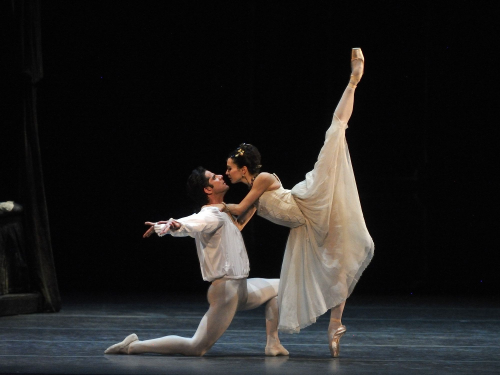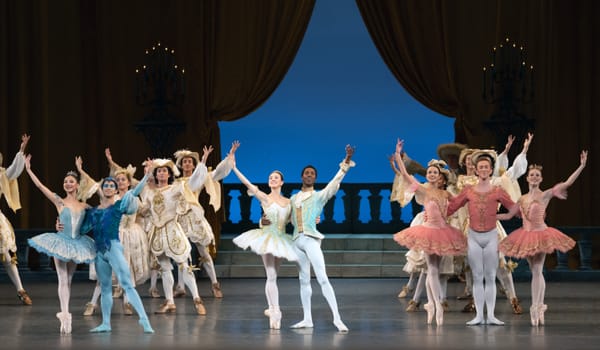Tragic Temptations

“Manon”
American Ballet Theatre
Metropolitan Opera House
New York, NY
June 7, 2014 (matinee)
From scandal in Paris to tragedy in a Louisiana swamp is a long way to go in a span of two hours, but Diana Vishneva and Marcelo Gomes made the journey seem realistic. Vishneva, celebrated her tenth anniversary with ABT at this performance, and took the opportunity to demonstrate her range, looking like a different woman in each of the three acts.
As the convent-bound Manon of the first act, Vishneva portrayed a curious young girl, slowly opening up to the world of love with tacit flirtation. She sat mesmerized when Gomes performed Des Grieux's solo; if each remarkably still arabesque balance was a tender word, she hung on every one. Oddly, at first Gomes seemed to have stumbled into the wrong ballet, making his Des Grieux as aloof as Onegin, but he quickly course-corrected after Des Grieux’s meeting with Manon with his palpable distress at losing her to Monsieur G.M. at the end of the first act. The lovers’ gentle yet passionate first duet showed their slow, building attraction and when MacMillan's choreography paused the action with Manon and Des Grieux sharing a kiss, Vishneva and Gomes made you feel as if time itself was suspended for those few moments.
The remarkable chemistry of their partnership was even more potent in the bedroom pas de deux. The speed of their lifts and turns made the couple look carefree and uplifted in their budding love, particularly Vishneva's unbelievably quick chaîné turns around Gomes. They made her seem airborne, as though she were caught swirling in the wind. Still, the couple danced without the all-consuming abandon one might expect in this pas de deux, restraining some of their movements and avoiding overdramatic reaches or uncontrolled runs toward each other. Their tone was less theatrical, which made the scene more accessible and real-looking and consequently more believable. If Gomes hadn’t yet found his footing by the bedroom scene, he softened his character enough to make his portrayal of the student Des Grieux more compelling. Any remaining reticence could have been interpreted as a result of disbelief at having had found someone like Manon.
By Act 2 Vishneva was a hardened woman, still open to the idea of love, but making all the wrong, materialistic choices when faced with temptation. She made the choreographic showpiece of the act -- the series of lifts where she was passed in the air by the many male corps dancers -- work to display her new character. She changed positions seamlessly and without care about how many hands she passed through. But despite being flirtatious, the lightness was gone from her steps, and she moved slowly. The dresses supplied by Monsieur G.M.'s money might have been pretty, but they also weighed her down.
Nothing was weighing down Misty Copeland in her playful portrayal of Lescaut's Mistress. Copeland’s self-assured solos were filled with jovial and seductive accents, but it wasn’t all friskiness for this courtesan – holding her head high, as though she was above this crowd, she looked as if she knew her worth. In the comic duet she performed with Herman Cornejo she seemed at once uncomfortable and unhindered by the awkward partnering of the drunk Lescaut. While Cornejo retained the determination with which he portrayed his scheming character throughout the ballet, it was only enough to show it was no match for the alcohol’s effects.
When the curtain went up for the final act set in a Louisiana penal colony, Vishneva looked as if she’d been through a physical and emotional war. Her body and soul would have appeared broken even without the tattered dress and cropped wig, but she held on to true love as she struggled to keep upright. When the loyal and romantic Des Grieux killed the Jailer, she fell apart completely, and the two dancers looked so desperate to restore the balance they had lost after all the wrong choices that befell them, that you almost thought they might succeed.
Their emotions bled into the final pas de deux, as burdened by Manon’s deteriorating state, they strove to execute each step as though it was their last. All elegance was gone; there was nothing left but tragedy. Although we knew her end was near, Vishneva’s Manon looked as if she were living her life to the end, rather than spending it dying. When she finally collapsed, her death looked so natural that, like Gomes, we could not believe she was really gone. While Gomes’ portrayal of his character had a more linear trajectory compared to Vishneva’s wild arc throughout the ballet, the shocking ending of the last scene completely unhinged him. Though it was still just theatre, this tragedy of “Manon” felt larger than life.
copyright © 2014 by Marianne Adams



